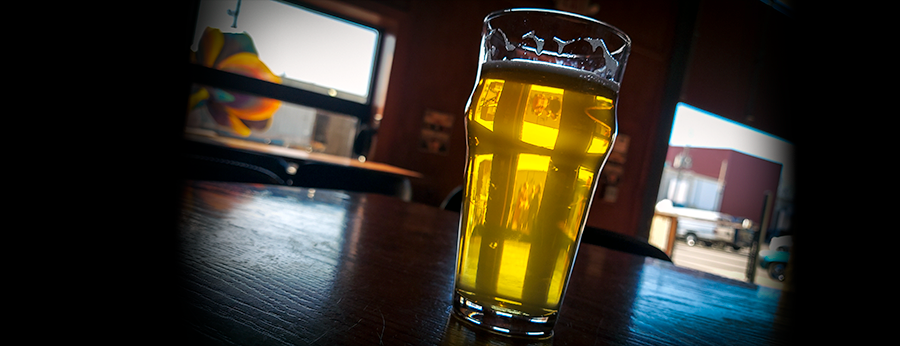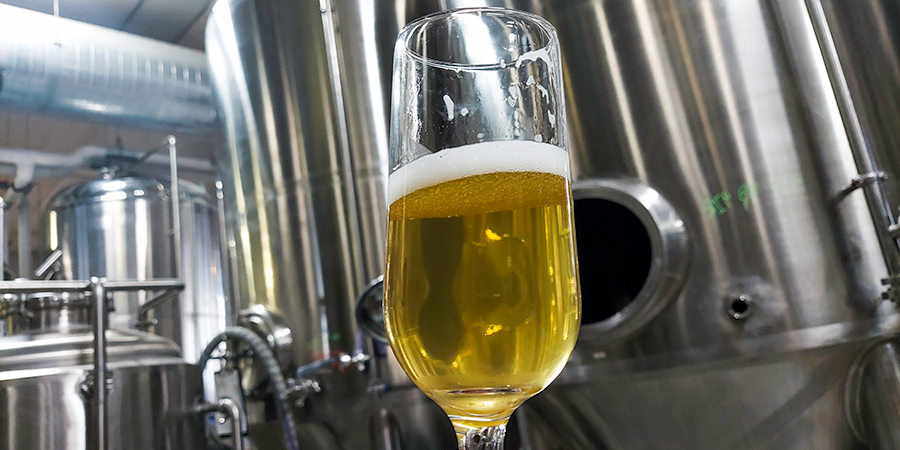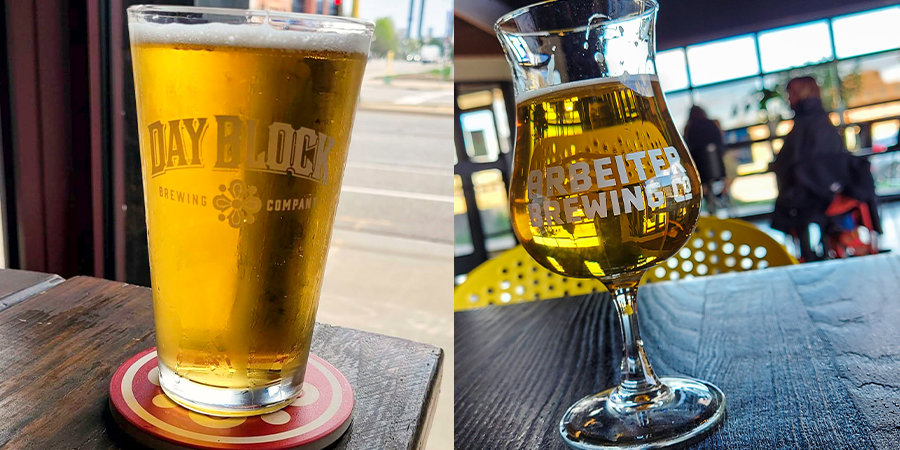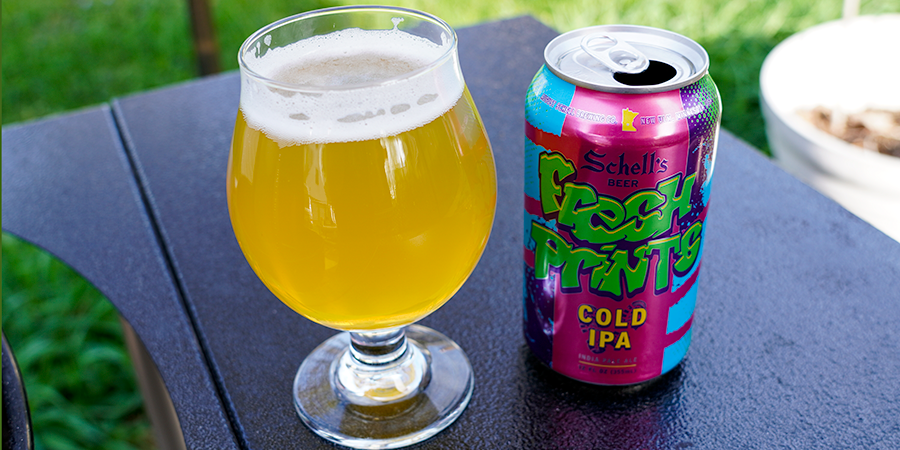May 17, 2022
What is a Cold IPA and How Do You Homebrew One?
Chip Walton | NB Digital Producer

A Cold Prediction
Only a quarter of the way through the year and 2022 already seems like it will go down as the Year of Cold IPA. Haven’t seen or tasted one yet? You likely will soon enough. Here in Minnesota, more than a dozen breweries have had one (or more) on tap over the past month, many of which were all the rage at the recent Craft Brewers Conference hosted in Minneapolis. These include Thawless Victory Cold IPA from Bent Brewstillery (pictured above). Everywhere you look things are coming up Cold IPA. So, if you’ve never heard of one, let us peel back the layers of the hop cone and tell you what we have learned about the style, why we love it, and how to go about brewing one at home – including two homebrew recipes from pro brewers.
“Wester Than West Coast”
First off, what a Cold IPA is not. It is very intentionally and specifically not a hazy IPA. In fact, Kevin Davey, brewer at Wayfinder Beer in Portland, Oregon, (who is credited with creating the style back in 2018 with Relapse Cold IPA) very pointedly proclaimed Cold IPA as the antithesis of Hazy IPAs. “We were trying to make something with the elements of West-Coast IPA but taken to the extreme,” Davey explains on Wayfinder’s website. “We wanted something drier with excessive hoppiness but a cleaner finish. Frankly, we tried to make a style of beer that could showcase American hops in a new way. Cold IPA hits with a strong punch of aromatic hop intensity and high bitterness, but finishes crisp and clean leaving the drinker craving another sip.”
Unlike Hazy IPAs it’s not hazy; doesn’t have a rich, heavy body; and doesn’t pour like grapefruit juice into your glass. It’s also not just a rebranded West Coast IPA, which has relatively more body and higher finishing gravity. Similarly, Cold IPA is different from what was known as Brut IPA (RIP) in that it’s not quite that dry and doesn’t require additional enzymes to achieve its final gravity. And, it sure as heck isn’t “just an IPL” as so many naysayers have accused, thanks to the inclusion of adjuncts in the grist, the fermentation regimen, and depending on the example, the way it’s hopped.
It is its own beautiful beast.

What is a Cold IPA?
At its core, a Cold IPA is an IPA that includes adjuncts – namely flaked rice and/or corn – in the grist, has no caramel malts, is fermented to a very low final gravity using a lager yeast at the higher end of its temperature range, and dry-hopped during fermentation. 2-Row or 6-Row malt might be used for the majority of the grist, but it really seems like brewers are leaning into Pils malts here to help keep the malt flavors from being too much in the foreground. These elements combined result in a beer with huge hop presence, light body, dry finish, and medium-to-low malt character. It is meant to be a showcase for hops.
I’ve heard it asked by doubters, “So… isn’t this a Warm Lager, not a Cold IPA?” First off, let’s be honest, would you ever buy a pint of something called “warm lager?” Probably not. Secondly, and in true craft beer fashion, here's where that thing that always happens with a new style kicks in. It doesn’t have to be a lager yeast. In Wayfinder’s Cold IPA style specs and manifesto, Davey decrees that brewers can substitute a lager yeast fermented warm and quick with an ale strain – such as Kölsch, Chico, or California Common – fermented on the cooler end, as long as the strain doesn’t create high sulfur or ester notes. Here he repeats the mantra, “Cold IPA is a canvas for IPA hops.”
Before we look at how professional brewers are making these beers, let’s recap some of the understood basics on the road map to brewing a Cold IPA. A malt bill that consists largely of Pils, 2-Row, or 6-Row base malt with flaked rice and/or corn as 20-40% of the grist. Mashed fairly low: 149-152°F. Hops aiming for 50-70 IBU with an emphasis on flavor/aroma hops towards the end of boil and whirlpool. Dry-hopping in fermenter at high krausen or when fermentation is about halfway complete. Fermented “warm” with a lager yeast in the lower 60s, or “cold” with ale yeast in the mid-upper 50s or low 60s. After fermentation, if possible, cold crash the fermenter to help force yeast and hops out of suspension. Remember, we want this beer to be fairly-to-brilliantly clear!

Left: Chillum Cold IPA from Day Block Brewing Company.
Right: Hoop Jump Cold IPA from Arbeiter Brewing Company, credited with being Minnesota’s first Cold IPA when released in Spring 2021
How the Pros Are Brewing Cold IPA
Bent Brewstillery brewed Thawless Victory Cold IPA (6.3% ABV) with 70% base malt, 20% flaked rice, and 10% sugar, then fermented it with 34/70 German Lager Yeast at 62°F. The beer was dosed with 100% Cryo Hops (Amarillo, Cryo Pop and Ekuanot) in whirlpool and dry-hopping. The flaked rice and sugar helped to dry the beer out, but those lush hops made it anything but thin or lacking. It has a wonderful lingering bitterness and hop character of bright citrus and stone fruit. Bent Brewstillery head brewer (and BJCP Education Director) Dr. Kristen England shares a homebrew-scale recipe for Thawless Victory and more thoughts on the Cold IPA brewing process below.
With the distinction of being the oldest craft brewery in America, August Schell Brewing Company is a long-standing lager powerhouse with a four-vessel brewhouse perfectly set up for making breakthrough styles such as Cold IPA. The grist for Fresh Prints Cold IPA is in line with that of a classic American adjunct lager: 60% 2-Row malt and 40% flaked corn. Hopped in the kettle with Centennial and sent to whirlpool dosed with Incognito Centennial (a new innovative hop oil product from John I. Haas). The wort is knocked out at 50°F and allowed to rise to 59°F during fermentation with Schell’s house lager yeast – an American lager yeast - which brewmaster Dave Berg says is similar to Schell’s general premium lager process. It’s dry-hopped with Talus and Amarillo. Fresh Prints has that immediately recognizable bitterness and foundation flavor of Centennial, with nuanced layers of light tropical fruit, lemon peel, and lemon shortbread. Its bitterness and light body make it crisp, in line with what Berg describes as “a highly hopped malt liquor that lands somewhere between a Brut IPA and West Coast IPA.” (Sounds like my desert island beer, honestly.)
For their Chillum Cold IPA (6.8%), Day Block Brewing used a third-generation pitch of Omega OYL-017 Kölsch I yeast fermented at 54°F to chew through a wort made of German Pilsner malt and toasted flaked rice. Final gravity: 1.003! They built a unique hop bill including HBC 522 for bittering with Azacca and Amarillo added throughout the boil and again to the fermenter during knock-out transfer. The HBC 522 provides a bitterness and up-front flavors reminiscent of classic Cascade and Columbus hops, with Azacca and Amarillo (in kettle, whirlpool and fermenter) providing layers of tropical citrus and grapefruit. The inclusion of about 20% toasted flaked rice in the grist gave the beer just a slightly toast-y vibe without the density that a darker, toastier malt might have on the body and finishing gravity. Day Block brewers Casey Tuck and Mike O’Hara shared with us a homebrew recipe for their Chillum Cold IPA; you’ll find it below as well.
BlackStack Brewing (7.0% ABV) is so all about this new style that they’ve created a Cold IPA series featuring an ongoing line-up of single-hopped Cold IPAs. So far, it’s included Simcoe & Chill and Strata & Chill. BlackStack uses Chico yeast fermented on the cooler side, around 60°F. Strata & Chill boasted a nose of huge strawberries and strawberry shortcake with lower notes of pineapple and dank.

Dave Berg, brewmaster at August Schell Brewing Company, describes Fresh Prints Cold IPA as a happy median between Brut IPA and West Coast IPA.
Brewing Cold IPA at Home
As you can see from the variety of methods and ingredients, if there is one truth about the increasingly popular Cold IPA it’s that it's not a one-trick pony. Depending on the yeast you use and, more importantly, the hop(s) you select and when you utilize them you can end up with wildly different results. Some examples of the style aim for the IBU range of 50-70 and include boil kettle additions; others, like the Thawless Victory recipe below, don’t. We encourage you to brew some iteration of this new style at home. To help you on your way, we have two homebrew-scale recipes shared with us by Twin Cities breweries: Bent Brewstillery’s Thawless Victory Cold IPA and Day Block Brewing Company's Chillum Cold IPA. Shout out to them and all the breweries included for sharing information with us for this article. If you brew your own version of these beers, please share your experience and photos/videos with us by tagging Northern Brewer on social media.
Stay cold, y’all!
Thawless Victory Cold IPA
Recipe provided by Dr. Kristen England, Bent Brewstillery (Roseville, MN). Kris also included his brewer’s notes and thoughts on the Cold IPA process.
OG: 16 Plato (1.064)
IBU: 30
Malt & Fermentables
- 70% U.S. Pils malt
- 20% flaked rice
- 10% white sugar
Mash at 151°F.
Recirculate for clarity and run off the wort into your boil kettle.
Hops
- Note: this Cold IPA recipe has no boil hops.
- Whirlpool hops:
- Amarillo® Cryo Hops® - 0.26 oz/gallon (1.29 oz for 5 gallons)
- Dry Hop at Day 3-4 (~50% attenuation):
- Cryo Pop™ Cryo Hops® - 0.387 oz/gallon (1.9 oz for 5 gallons)
- Ekuanot Cryo Hops® - 0.387 oz/gallon (1.9 oz for 5 gallons)
- Dry hop at final gravity with temperature decreased to 55°F
- Cryo Pop™ Cryo Hops® - 0.13 oz/gallon (0.64 oz for 5 gallons)
- Ekuanot Cryo Hops® - 0.13 oz/gallon (0.64 oz for 5 gallons)
Yeast
Brewer’s Notes:
Grist
I've done these with European Pils malts and American Pils malts, and find most European stuff just too flavorful for what I want here. I'm looking for a great malt backbone without it being too complex. To me, Rahr North Star Pils really fits that bill very well. I've also done these varying the amounts and ratios of adjuncts. Any time I've had corn in it, it very much has an 'old style' lager character which I don't want. I found that 2:1 rice:sugar works great. You can absolutely do all rice and it works wonderfully well. Straight sugar tends to thin out too much in my opinion.
Hops
Really completely up to the brewer. For the beer above – and the whole 'cold' theme – I went entirely with Cryo hops, but standard T90s work great also. Cryo hops really do keep this beer pretty clear without having to filter and only gently fine. That said, personally, Cryo removes some of the 'soul' of an IPA in my opinion – lacks some of the greenery and texture for sure.
Yeast
This is pretty much the crux of the 'cold' IPA style: lager yeast, fermented cooler than most ale temps but warmer than lager temps. I really like 34/70 for this beer as it has pretty good β-lyase activity, so I prefer to put the biggest dose of these hops in while fermentation is still quite active. (Read, more tropical flavors.) 34/70 also doesn't crap a lot of sulfur nor VDK at that temperature. It drops nice and bright too.
Chillum Cold IPA
Recipe provided by Day Block Brewing Company brewers Casey Tuck and Mike O’Hara. If you are unable to source HBC 522 hops, they suggest substituting Cascade or Centennial for the bittering charge. The guys are also big fans of adding hops to their fermenter as they are transferring cooled wort into the tank, so these hops are essentially primary fermentation hops and are in the tank for the full duration of fermentation.
For 5 gallons
OG: 1.055
FG: 1.003
ABV: 6.8%
IBU: 67
Malt & Fermentables
- 8 lbs 0.2 oz Weyermann Pilsner malt (80%)
- 2 lbs 1.1 oz toasted flaked rice (20%)
- 1 lb rice hulls (optional, but suggested)
Mash at 152°F for 60 minutes. Run off and collect wort. Bring wort to a boil for 60 minutes.
Hops
- 0.7 oz HBC 522 (13%aa) - 60 minutes
- 0.7 oz Azacca (15%aa) - 30 minutes
- 0.7 oz Amarillo (9.2%aa) - 10 minutes
- 0.4 oz Azacca - Steep/Whirlpool at 195F for 20 minutes
- 0.4 oz Amarillo - Steep/Whirlpool at 195F for 20 minutes
- 1.2 oz Azacca - Added to primary fermenter before transferring cool wort
- 1.2 oz Amarillo - Added to primary fermenter before transferring cool wort
Yeast
After 60-minute boil, flame-out and steep/whirlpool hops at approximately 195F for 20 minutes. Chill wort to 54°F and pitch yeast. Ferment at 54°.
Watch our some of our own team talking about and tasting Cold IPAs below.
Suggested Reading
- What is a Cold IPA? (Wayfinder Beer)
- Is Cold IPA Really a New Beer Style? (And Does it Even Matter)? (CraftBeer.com)
- John Palmer’s Cold IPA Recipe (with Notes) (Beer & Brewing)
- Karl Strauss and Sierra Nevada Debut Their Red-Hot Collaboration on a Cold IPA (Brewbound)

